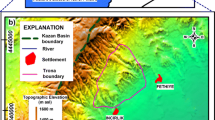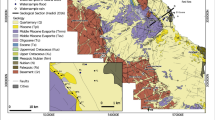Abstract
The results of the hydrogeochemical study of poorly mineralized thermal groundwaters from the Kuldur Spa (Jewish Autonomous Region, Russia) are reported. These groundwaters are distinguished by their high temperature (73°С), low TDS (up to 0.38 g/L), and alkaline environment (pH 9). The dominant cation is sodium, and the dominant anion is hydrocarbonate. The waters are enriched in fluorine, silicon, aluminum, tungsten, molybdenum, and several other anionic elements. Detailed data on the chemical and mineral composition of water-hosting (intrusive) rocks are provided and the sources of the major brine components in the groundwaters are revealed. The study of the associated gases shows that the major component of the gaseous phase (N2) is atmogenic, while CH4 and CO2 are biogenic. Argon and oxygen are derived from air as well, whereas helium is predominantly of the radiogenic crustal origin. The isotope characteristics of oxygen and hydrogen in the aqueous phase indicate the undoubtedly meteoric genesis of the groundwater with an extended circulation period. The results suggest that the thermal groundwaters of the spa are formed via penetration of meteoric waters to a depth of 4 km and heating to 100 °C. The dissolved chemical elements that form the brine phase come via the dissolution of host rocks; however, since the groundwater circulates within the rocky massifs of poorly soluble granitoids, respectively, the TDS of the groundwater remains low.







Similar content being viewed by others
REFERENCES
Barabanov, L.N. and Disler, V.N., Azotnye termy SSSR (Nitrogen Thermal Springs in the USSR), Ivanov, V.V., Ed., Moscow: Geominvod TsNII KiF, 1968.
Baryshnikov, G.Ya. and Eliseev, V.A., Siliceous thermal healing waters of the Altai–Sayan Mountain Range, Izv. Altai. Gos. Univ., 2009, no. 3 (63), pp. 41–47.
Belhai, M., Fujimitsu, Y., Bouchareb-Haouchine, F., et al., A hydrochemical study of the Hammam Righa geothermal waters in north-central Algeria, Acta Geochimica, 2016, vol. 35, pp. 271–287.
Bragin, I.V., Chelnokov, G.A., Chudaev, O.V., et al., Geochemistry of thermal Waters of continental margin of far East of Russia, Acta Geol. Sinica (English ed.), 2016, vol. 90, no. 1, pp. 276–284. https://doi.org/10.1111/1755-6724.12657
Bragin, I.V., Kharitonova, N.A., Chelnokov, G.A., et al., REY geochemistry in groundwater from Paratunka geothermal area (Kamchatka peninsula, Far East of Russia), Environ. Earth Sci., 2018, vol. 77, pp. 376–389. https://doi.org/10.1007/s12665-018-7571-7
Bragin, I.V., Chelnokov, G.A., and Kharitonova, N.A., Geochemistry of thermal springs at Baransky volcano, Southern Kuriles (Russia), Environ. Earth Sci., 2019, vol. 78, no. 3, pp. 79–89.
Buchko, I.V., Sorokin, A.A., and Kudryashov, N.M., Late Paleozoic gabbroids of the Lesser Khingan terrane of the eastern Central-Asian fold belt: Age, geochemistry, and tectonic setting, Russ. J. Pac. Geol., 2013, vol. 7, no. 3, pp. 189–198.
Chelnokov, G.A., Bragin, I.V., Kharitonova, N.A., et al., Geochemistry and formation conditions of the Ulsk thermal spring, the Okhotsk Sea coast, Khabarovsk territory, Russ. J. Pac. Geol., 2019, vol. 13, no. 2, pp. 163–175.
Chelnokov, G., Bragin, I., and Kharitonova, N., Hydrochemistry of thermal waters in crystalline rocks of the Sikhote-Alin ridge, Far East of Russia, E3S Web of Conferences, 2019, vol. 98. https://doi.org/10.1051/e3sconf/20199807006
Chudaev, O.V., Kharitonova, N.A., Chelnokov, G.A., et al., Geokhimicheskie osobennosti povedeniya redkozemel’nykh elementov v vodakh Dal’nego Vostoka Rossii v usloviyakh prirodnykh i antropogennykh anomalii (The Geochemical Behavior of Rare Earth Elements in Waters of the Russian Far East in Environments of Natural and Manmade Anomalies), Vladivostok: Dal’nauka, 2017.
Demonova, A.Yu., Kharitonova, N.A., Korzun, A.V., et al., The chemical composition of the nitrogen thermal waters of the Khoja-Obi-Garm (Tajikistan) balneoclimatic resort, Moscow Univ. Geol. Bull., 2017, vol. 72, no. 5, pp. 455–462.
Demonova, A.Yu., Kharitonova, N.A., Bragin, I.V., et al., Microcomponent composition of low-mineralized nitrogen thermes of the Gissar Ridge (Pamir-Alay Mountain System), in Izv. Tomsk Politekhn. Univ. Inzh. Georesursov (Bull. Tomsk Polytechn. Univ. Geo Assets Eng.), 2019, vol. 330, no. 9, pp. 7–20.
Fournier, R.O. and Potter, R.W. II, A revised and expanded silica (quartz) geothermometer, Geoth. Res. Council Bull., 1982, vol. 11, pp. 3–12.
Haskin, M.A. and Haskin, L.A., Rare earths in European shales: a redetermination, Science, 1966, vol. 154, pp. 507–509.
Kireeva, T.A., Salikhov, F.S., Bychkov, A.Yu., and Kharitonova, N.A., Chemical composition and parameters of formation of the waters of some thermal springs in Tajikistan, Geochem. Int., 2020, vol. 58, no. 4, pp. 423–434.
Kompanichenko, V.N. and Poturay, V.A., Hydrogeochemical zoning and composition evolution of Kuldur thermal water field (the Far East), Geoecol. Eng. Geol. Hydrogeol. Geocryol., 2015, no. 6, pp. 521–534.
Kulakov, V.V., Geological, structural and geothermal conditions of the formation of thermal groundwater in the Amur Region, Tikhookean. Geol., 2014, vol. 33, no. 5, pp. 66–79.
Kulakov, V.V. and Sidorenko, S.V., Mineral’nye vody i lechebnye gryazi Priamur’ya (Mineral Waters and Therapeutic Muds in the Amur Region), Khabarovsk: Dal’nevostochn. Gos. Med. Univ., 2017.
Lavrushin, V.Yu., Podzemnye flyuidy Bol’shogo Kavkaza i ego obramleniya (Underground Fluids in the Greater Caucasus and Its Frame), Moscow: GEOS, 2012.
Pearce, J.A., Harris, N.B.W., and Tindle, A.G., Trace element discrimination diagrams for the tectonic interpretation of granitic rocks, J. Petrol., 1984, vol. 25, pp. 956–983.
Pinneker, E.V., Regularities in distribution and formation of groundwater, in Problemy regional’noi gidrogeologii (Problems of Regional Hydrogeology), Moscow: Nauka, 1977.
Plyusnin, A.M., Zamana, L.V., Shvartsev, S.L., et al., Hydrogeochemical peculiarities of the composition of nitric thermal waters in the Baikal rift zone, Russ. Geol. Geophys., 2013, vol. 54, no. 5, pp. 647–664.
Polyak, B.G., Tolstikhin, I.N., and Yakutseni, V.P., The isotopic composition of helium and heat flow: Geochemical and geophysical aspects of tectogenesis, Geotectonics, 1979, vol. 13, no. 5, pp. 339–351.
Poturay, V.A., Organic matter in ground and surface waters in the area of the Kuldur geothermal field, Russian Far East, Vestn. KRAUN. Nauki o Zemle, 2013, no. 1, pp. 169–182.
Rychkova, K.M., Heat flow in Tuva based on He-isotope and geothermal data, Cand. (Geol.-Mineral.) Dissertation, Novosibirsk, 2009.
Sano, Y. and Wakita, H., Geographical distribution of 3He/4He ratios in Japan: implications for arc tectonics and incipient magmatism, J. Geophys. Res. Solid Earth, 1985, vol. 90, no. B10, pp. 8729–8742.
Shestakova, A.V. and Guseva, N.V., Calculation of deep temperatures of thermal waters in Eastern Tuva, in Izv. Tomsk Politekhn. Univ. Inzh. Georesursov (Bull. Tomsk Polytechn. Univ. Geo Assets Eng.), 2018, vol. 329, no. 1, pp. 25–36.
Shvartsev, S.L., Zamana, L.V., Plyusnin, A.M., and Tokarenko, O.G., Equilibrium of nitrogen-rich spring waters of the Baikal Rift Zone with host rock minerals as a basis for determining mechanisms of their formation, Geochem. Int., 2015, vol. 53, no. 8, pp. 713–725.
Slavyanov, N.N., Termy i gazy Tyan’-Shanya (Thermal Springs and Gases of Tien Shan), Moscow: Izd. Akad. Nauk SSSR, 1938.
Sorokin, A.A., Kotov, A.B., Sal’nikova, E.B., et al., Granitoids of the Tyrma-Bureya complex in the northern Bureya–Jiamusi superterrane of the Central Asian Fold Belt: Age and geodynamic setting, Russ. Geol. Geohys., 2010, vol. 51, no. 5, pp. 563–571.
Sun, S.-S. and McDonough, W.F., Chemical and isotopic systematic of oceanic basalts: implications for mantle composition and processes, Geol. Soc., 1989, vol. 42, pp. 313–345.
Zamana, L.V., Isotopes of hydrogen and oxygen in nitrogen hot springs of Baikal Rift Zone in terms of interaction in the water–rock system, Dokl. Earth Sci., 2012, vol. 442, no. 1, pp. 81–85.
ACKNOWLEDGMENTS
The authors are grateful to V.Yu. Lavrushin and O.E. Lepokurova for constructive remarks that helped to significantly improve the manuscript.
Funding
This study was supported by the Russian Foundation for Basic Research, project no. 18-05-00445_a and RFBR and JSPS project no. 19-55-50002.
Author information
Authors and Affiliations
Corresponding authors
Additional information
Translated by A. Bobrov
About this article
Cite this article
Kharitonova, N.A., Lyamina, L.A., Chelnokov, G.A. et al. The Chemical and Isotope Composition of Nitrogen Thermal Groundwaters of the Kuldur Spa (Jewish Autonomous Region, Russia). Moscow Univ. Geol. Bull. 75, 621–635 (2020). https://doi.org/10.3103/S014587522006006X
Received:
Revised:
Accepted:
Published:
Issue Date:
DOI: https://doi.org/10.3103/S014587522006006X




